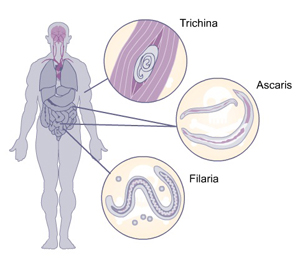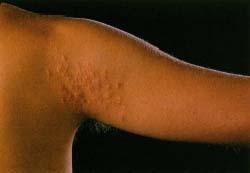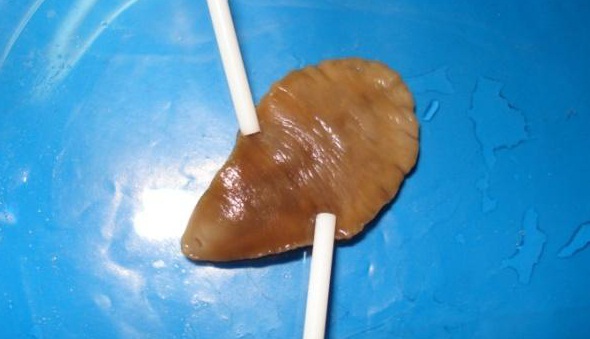Bio-resonance Therapy for Parasites
Most people would love to dismiss any suggestion that they have Parasites within them, even doctors. But the reality is that most of the world’s 7 billion people are infected with Parasites.
This page is becoming the most visited on the site so we will be working hard to improve it, please bookmark and keep returning. Bookmark This Page Now
You may feel that parasites are not a problem in the UK so why look into treatment for human parasites, however, our therapists on a daily basis kill parasites that have infected their clients – with evidence in the stool samples that can be seen with the naked eye. After Bio-resonance therapy for parasitic infection, symptoms may subside after a few days, some people have seen the evidence in the toilet bowl which proves to us that it really works.
If you travel or live with people who travel, eat red meat, pork and chicken or have pets then it is probable that you have some intestinal parasites.
There are many types of parasitic worms (helminths) that use the human body as their host. These include roundworms, pinworms, hookworms and flatworms. Some species can be found in the intestinal tract, laying eggs inside their host. Other organisms that can infect humans include parasitic protozoa.

A 1995 estimate by the WHO of the number of people infected world-wide gave the following degree of infestation for specific parasitic species:
Toxoplasma gondii – 50% infestation
Ascaris spp. – 1.2 billion
Enterobius vermic./Oxyuris – 1.2 billion
Trichuris trichiura – 600 million
Ancylostoma duod. – 500 million
Entamoeba histol. – 500 million
Pneumocystis carinii – 400 million
Obviously nowhere near all parasite infections are recognised as such. If we assume also a certain number of unrecorded cases, which is bound to be high, we can assume that at least 50% of the world’s population is infested with protozoa and helminths.
In general, all those with impaired immune systems are at risk, whether this condition is the result of stress factors or of immunosuppressive therapy, e.g. for primary chronic polyarthritis or multiple sclerosis. However, parasite infection may also contribute to hypoimmunity or even immune blocks in their host by fending off the human immune system.
As a part of bioresonance therapy to treat parasitic infections a good therapist will always strengthen the immune system before treatment, especially infants as well as the elderly and infirm are most at risk.
Parasitic diseases
Roundworms
Intestinal roundworms, also called ascaris, are found in many parts of Asia and in the southern U.S. They frequently infect the lungs or intestines and can even be coughed up. The eggs produced by the adult worms are very resistant, and can live in soil in either freezing or hot, dry weather.
Bio-resonance therapy for ascaris worms include testing to see if you have them first. They are transmitted by contaminated food and a number of cases show that humans can become very ill after becoming infected through eating infected sushi. Please see an instance of Anisakis simplex here.
Pinworms
Pinworms are a fairly common infestation in children, and are very hard to control or eliminate without bioresonance treatment. The worms lives in the large intestine. The adult worm moves to the anus to lay eggs in their thousands. Often these eggs are transmitted from a child’s fingers from the itching anal area to the mouth, which can create a perpetual infestation. In addition, the parasite eggs that are expelled may live in the external enviroment for months.
As you can imagine, washing hands, keeping fingernails clean, and avoiding putting fingers in the mouth are all essential to breaking the Pinworms lifecycle. The good news is that bioresonance has proved an effective treatment for different parasites and especially Pinworms. Watch a colonoscopy showing pinworms
Hookworms


Hookworms are parasites that cause an intestinal infection in the small intestine and suck blood from the host, leading to anemia.
The eggs are distributed in the soil, and after they hatch, the larvae are able to penetrate the intact skin of bare feet. The best prevention of this parasitic disease is proper sanitation and wearing shoes in areas where soil is contaminated.
If you want to check if you have hookworms the best method is bioresonance testing followed by a treatment for parasites using the BICOM® Optima. This picture is courtesy of St. Bartholomews Hospital. For more information on Hookworm disease in humans, visit the World Health Organisation – Hookworm disease
Also watch this video about a cat scratch infecting owner click here
Other roundworms
The small worm trichina is found in undercooked pork. After ingestion, the worm travels to the muscles of the host and causes a disease known as trichinosis. It is essential to remove trichina using the BICOM® Optima, an effective bio-resonance treatment for may parasites.
Filaria is found in tropical areas such as Asia and the South Pacific. It is transmitted by bites from flies and mosquitoes. The worm grows in large numbers and can infect the lymphatic vessels, causing an enlargement of the scrotum and the lower extremities – a condition called elephantiasis.
Flatworms
These include tapeworms, which are spread by infected improperly cooked meats. Tapeworms have been known to come out themselves as this video shows. Tapeworms infect the intestine, but other flatworms may infect the blood, lungs or liver.
It’s important you visit a qualified bioresonance practioner for early treatment because a tapeworm can grow to a few meters in length and the frequencies can vary over its length. Watch this video showing intestinal worms being removed in a 3 year old.
Brain worms – Neurocysticercosis
It is not uncommon as this video shows of patients being diagnosed with brain tumours, cysts or other problems only to find the problem comes from parasites that have entered the brain area. Bioresonance treatment for parasites combined with herbal remedies can identify and treat the parasite, their eggs and associated virus.
Ringworm


Ringworm or Tinea is a typically mild disease of the skin, scalp or nails caused by a fungus. Personal hygiene, supported by availability of adequate quantities of drinking water are important measures of preventative disease control.
On the scalp, ringworm begins in the form of a pimple or sore, which then spreads into a ring shape. Symptoms can include hair becoming brittle, breaking easily and falling out, leaving bald spots on the scalp. On the body, ringworm may first appear as red or pink, flat or slightly raised, patches on the skin. The circular sores may be dry or scaly crusted or moist. As the sores become larger, the central area clears, leaving a ring of infected tissue around the clear area.
Infection in the nails usually begins at the site of an injured nail and may spread to the other nails. Infected nails become thick, pitted, grooved and abnormal in shape and colour. A bioresonance practioner with a parasite database can identify if tinea or other parasites are present under the skin.
Fasciolopsis buski – intestinal flukes


Fasciolopsis buski, also called giant intestinal fluke, is a duodenal digenetic trematode, of the Fasciolidae family. It was described for the first time by Busk in the duodenum of a sailor in 1843 in London and its life cycle in humans was first described by Barlow in 1925.
Mainly found in Southeast Asia, it is found in food such as contaminated water chesnuts, bamboo, water caltrops etc. The parasite fasciolopsis buski has been found in many people with cancer, so as a possible trigger, it is important to have bioresonance treatment for these parasites.
Articles
Order a Parasite Blood Test using the BICOM®

